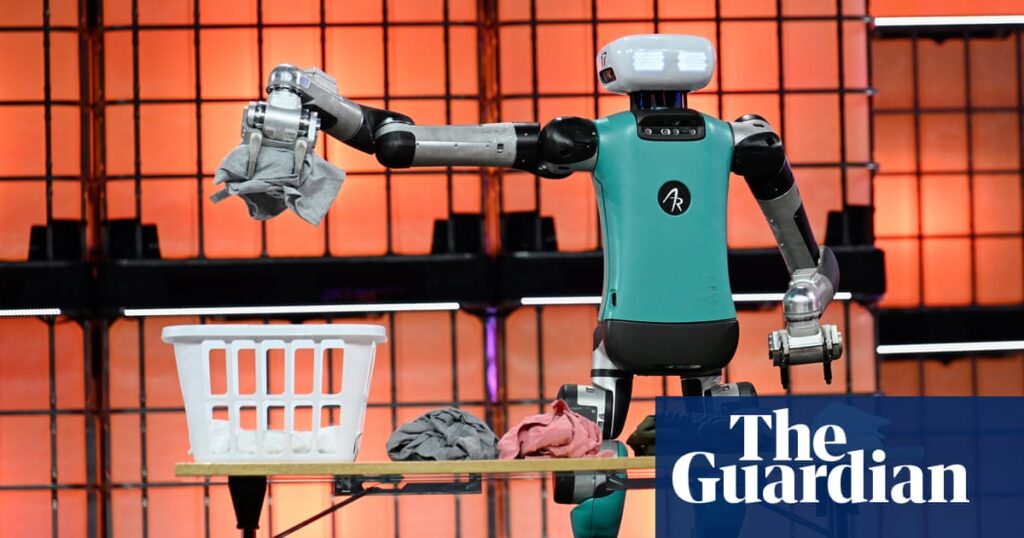The AI Buzz at Web Summit 2023: Robots, Jobs, and Sustainability
This year’s Web Summit in Lisbon was a vibrant celebration of artificial intelligence, highlighted by a quirky showcase of a robot handling laundry. Meet Digit, a humanoid robot crafted by Agility Robotics, which demonstrated its skills by sorting colored T-shirts in response to voice commands powered by Google’s Gemini AI model. The demonstration wasn’t flawless, but the enthusiastic cheers from attendees underscored the palpable excitement surrounding AI innovations nearly two years after the advent of ChatGPT.
Job Security: What’s Next?
One of the hot topics of discussion at the summit revolved around job displacement due to AI. Experts debated whether the millions of jobs potentially lost to automation would be replaced by new roles as the tech creates fresh opportunities. With AI tools, especially autonomous agents, poised to take over entry-level tasks in various professional sectors—from law to finance—it raises some serious concerns.
Sarah Franklin, CEO of Lattice, highlighted that AI could reshape workforce structures. “AI can make this more of a diamond shape, where the entry levels are harder to get,” she noted. This potential change could heavily impact entry-level roles, traditionally the backbone of upward workforce mobility. With the pace of AI innovation accelerating faster than education systems can adapt, there’s an urgent need to bridge this gap, particularly for those at the start of their careers.
Interestingly, Digit isn’t just about job loss; it’s also about potential new roles. Peggy Johnson from Agility Robotics mentioned how roles like “robot manager” could emerge, allowing human workers to shift focus from mundane tasks to more strategic responsibilities. “Employees appreciate that they can hand off physical work to Digit,” she shared.
AI and the Climate Crisis
The environmental impact of AI was also a significant conversation point. Concerns about energy-hungry data centers, which support the training and operation of AI models, suggested that the increasing demand for energy could strain local resources. Sarah Myers West from the AI Now Institute emphasized the importance of considering the implications for both the climate and local communities.
Key players in tech, like Microsoft’s president Brad Smith, acknowledged this issue during the keynote, asserting, “We can’t afford to just build data centers and consume electricity without regard for what it means for a local community or for a country or for planet Earth.” Microsoft is even facing challenges in achieving its carbon negative target by 2030 due to these energy demands.
However, not all conversation was grim. Shawn Xu from Lowercarbon Capital remarked on the potential for investment opportunities that connect clean energy resources with AI demands. “For 2025, AI strategy is energy strategy. It is a very critical pillar for AI infrastructure,” he said.
Safety First: Navigating Risks
While the summit buzzed with enthusiasm for AI’s potential, it was essential to maintain a prudent perspective. Professor Max Tegmark from MIT warned of the dangerous consequences of unrestrained AI development, suggesting that we find ourselves at a “fork in the road” where we could either face severe threats or usher in beneficial eras.
A Battle for Creativity
The intersection of AI and creativity was another hot topic. Steven Knight, the mastermind behind “Peaky Blinders,” asserted that while AI could assist in creative processes, it would never fully replace the human element. “When a creative human being creates something new, the reason it works is because it’s not expected,” he explained.
At the same time, Marco Bassetti, CEO of Banijay, indicated that AI could streamline the creative process, making brainstorming quicker and more efficient. But while AI might optimize processes, it lacks the spark of true human creativity.
The Road Ahead for AI Development
After a whirlwind of innovation, there were murmurs that the AI race might cool down, with some recent models underperforming against lofty expectations. However, breakthroughs have led to exciting ventures, such as Healx, a startup dedicated to finding cures for rare diseases through AI.
As Kanu Gulati from Khosla Ventures highlighted, even companies that aren’t building the latest models are leveraging them to create novel business opportunities. “New business models can now get created,” he stated, emphasizing the necessity for investors and tech firms to adapt.
Conclusion
The Web Summit 2023 was a illuminating experience, showcasing the immense potential of AI while also addressing critical concerns about job displacement, climate impact, and creativity. As technology evolves, it will be fascinating to see how these discussions shape our future.
The AI Buzz Hub team is excited to see where these breakthroughs take us. Want to stay in the loop on all things AI? Subscribe to our newsletter or share this article with your fellow enthusiasts.




